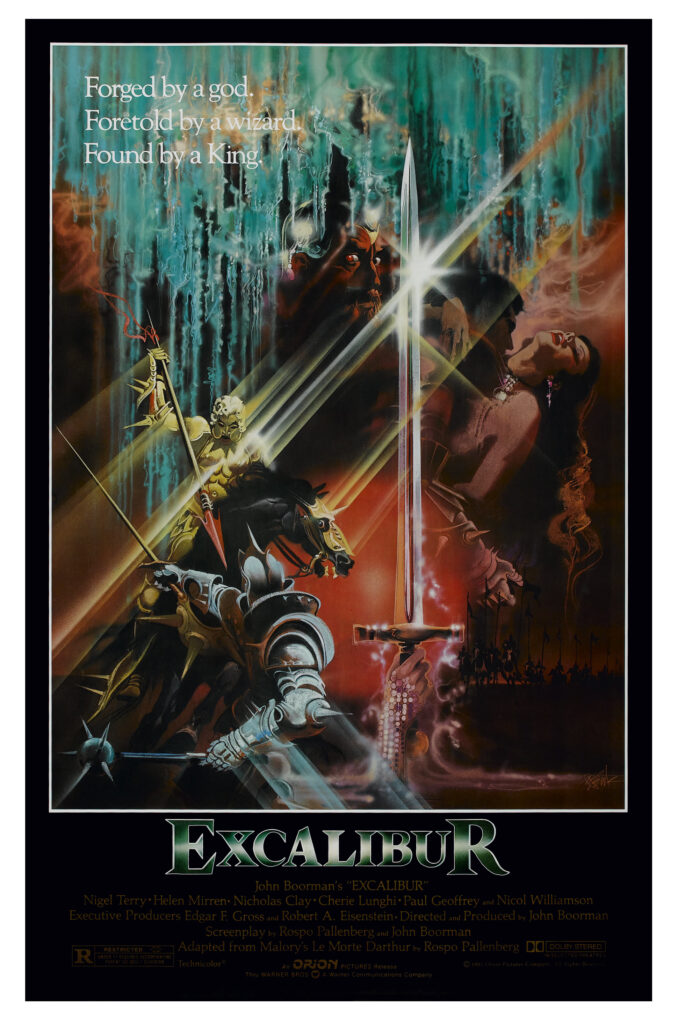
Excalibur by Chris Crawford, Valerie Atkinson and Larry Summers, published by APX, USA
First release : September 1983 on Atari 8-bits
Tested on : Atari 8-bits emulator (Altirra)
Total time tested : I lost count ! Probably more than 15 hours.
AAR : Part 1, Part 2, Part 3, Part 4
Average duration of a campaign: Varies a lot, but probably never less than 4 hours.
Complexity: High (3/5)
Would recommend to a modern player : No
Would recommend to a designer : Yes, to anyone interested in the history of video games
Final Rating: ☆☆
Ranking at the time of review : 34/93 [edit 03/02/2025: looking back I was tough on the game, so I re-assessed at two-stars and 35/158].
Summary :
Excalibur featured an unparalleled scope and an array of groundbreaking concepts for 1983. However, due to a tumultuous development process, its individual features were underdeveloped and occasionally unfinished, resulting in an immersive yet disjointed experience. Still, had it not been an Atari-exclusive title launched on APX during the 1983 video game crash, Excalibur might have had a similar impact on the industry as Eastern Front 1941. Instead, its obscurity left it without any notable influence.
Chris Crawford, who had arguably become the most renowned American video game designer in the early 80s due to the tremendous success of Eastern Front 1941, was simultaneously establishing the foundation for the Atari ecosystem. As the supervisor of the Atari Software Development Support group since December 1980, Crawford collaborated on a series of technical articles in computer magazines, notably Byte, and ultimately published with others De Re Atari (1982) – the definitive guide to Atari development.

When Alan Key was recruited by Atari to form the Atari Research Unit in late 1981, he naturally sought to include in his team the prodigious designer with an impeccable technical background. Crawford was granted complete creative freedom and given a single directive : dream big, even at the risk of failure. Reflecting on the essence of games, he realized that prior games, whether arcade, adventure or wargames, had primarily focused on objects. Consequently, Crawford resolved that his next game would centre on people.
Although his upcoming project would still be a wargame, it would not emphasize battles. Instead, it would focus on the context surrounding the conflicts: diplomacy, culture, and most importantly, leadership – the elusive art of managing people. In this game, war would be “a viable option that must sometimes be exercised, but not frivolously. […] A game that warmongers would inevitably lose.” That was the plan, at least.
Initially, Crawford envisioned a post-apocalyptic America as the game’s setting. However, he soon replaced this idea with another post-apocalyptic era, one with a richer historical context: Sub-Roman Britain. From the perspective of the sub-Roman Britons, the 5th and 6th centuries were indeed “post-apocalyptic.” Roman authority had collapsed, cities reliant on trade with the Empire had been abandoned, and the Britons now had to survive in a new, hostile world. Alas, Crawford there were few charismatic leaders on the Briton side. This led him to explore Arthurian legends, which naturally centred around the iconic figure of King Arthur. In early 1982, watching the movie Excalibur left a profound impression on Crawford (“it shamed me with its excellence”). It locked the theme and gave the game its intro and its title.
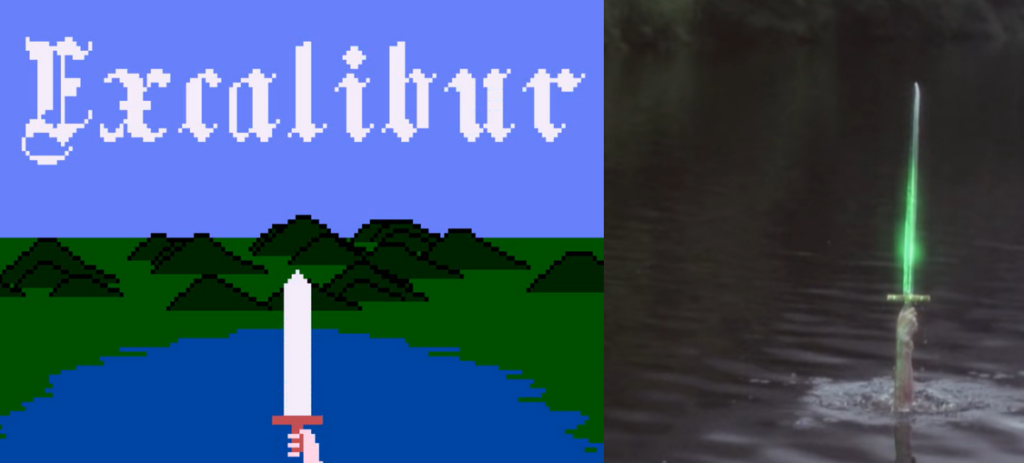
By April 1982, Crawford had determined that his game would encompass 4 nested games, which he called “CAMELOT”, “BRITAIN”, “BATTLE”, and “JOUST”. The latter was supposed to occur when fighting an enemy king on the battlefield. After testing various designs for that mini-game (one of which was described as strikingly similar to the jousting mini-game of Defenders of the Crown), he decided it would never fit the rest of the game and abandoned it, leaving three parts to Excalibur.
With a solid general idea of his design, Crawford enlisted the assistance of two junior Atari employees – Larry Summers and Valerie Atkinson. Summers was assigned the BRITAIN portion, and Atkinson took on CAMELOT; Crawford would maintain the high-level vision while also implementing the BATTLE mini-game and designing the “Leadership” aspect of Excalibur: the relationship between Arthur and his knights.

Crawford became preoccupied with the Leadership component of the game, creating a system in which the knights would have relationships not only with Arthur but also among themselves. This dynamic would subsequently influence their relationship with Arthur as they formed gossipy “echo chambers”. Eventually, the Leadership mini-game evolved to the point that it was adapted to a modern context and became a new game released on APX: Gossip. It was later re-incorporated, albeit significantly simplified, into Excalibur.
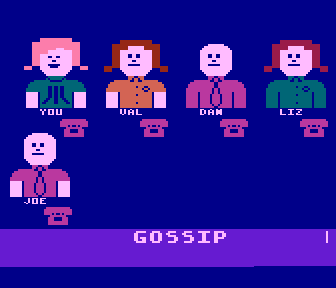
This was the last design victory for quite some time. In the second half of 1982, Crawford’s commitments multiplied (the re-release of Eastern Front 1941 by Atari, annotating the source code for an upcoming APX release, writing his book The Art of Computer Game Design, and in his free time the modernisation of Legionnaire [1982] for Avalon Hill), leaving little bandwidth for Excalibur. Consequently, Summers and Atkinson had to work alone on a design that was sometimes incomplete or dysfunctional, and Crawford admits he failed to provide satisfactory solutions to many of his design’s shortcomings: “Since I had so little time to devote to the project, I did a great deal of designing by the seat of my pants. In our regular weekly meetings, they would present me with the latest design flaw they had uncovered. Having no clear memories of previous decisions, I would hack together an ad hoc solution. My intuitions are fairly good, and many times I got away with these deplorable techniques. However, many of my on-the-fly decisions fell apart and wrought havoc with the overall design. Poor Valerie put features into the CAMELOT module, only to have them stripped out, then later re-installed. Our records for this period indicate a great deal of wasted effort.”
Crawford finally returned to the project in January 1983, and by then, everyone wanted the project out. Closing it became the priority, with no new features added and many cuts. There were a few exceptions: the coding of the well-isolated BATTLE module by Crawford, the final touches on the “Leadership” mini-game, and the AI for the other kings. This process was arduous and left many parts of the game shallow or poorly integrated, but it had been necessary : finishing the game took six more months, with a first beta shipping to APX in late June and the game’s completion on July 28th, 1983, just hours before the final deadline set by APX… only for the game, as Crawford puts it, to be “lost in the dust of the disaster” of Atari’s collapse.
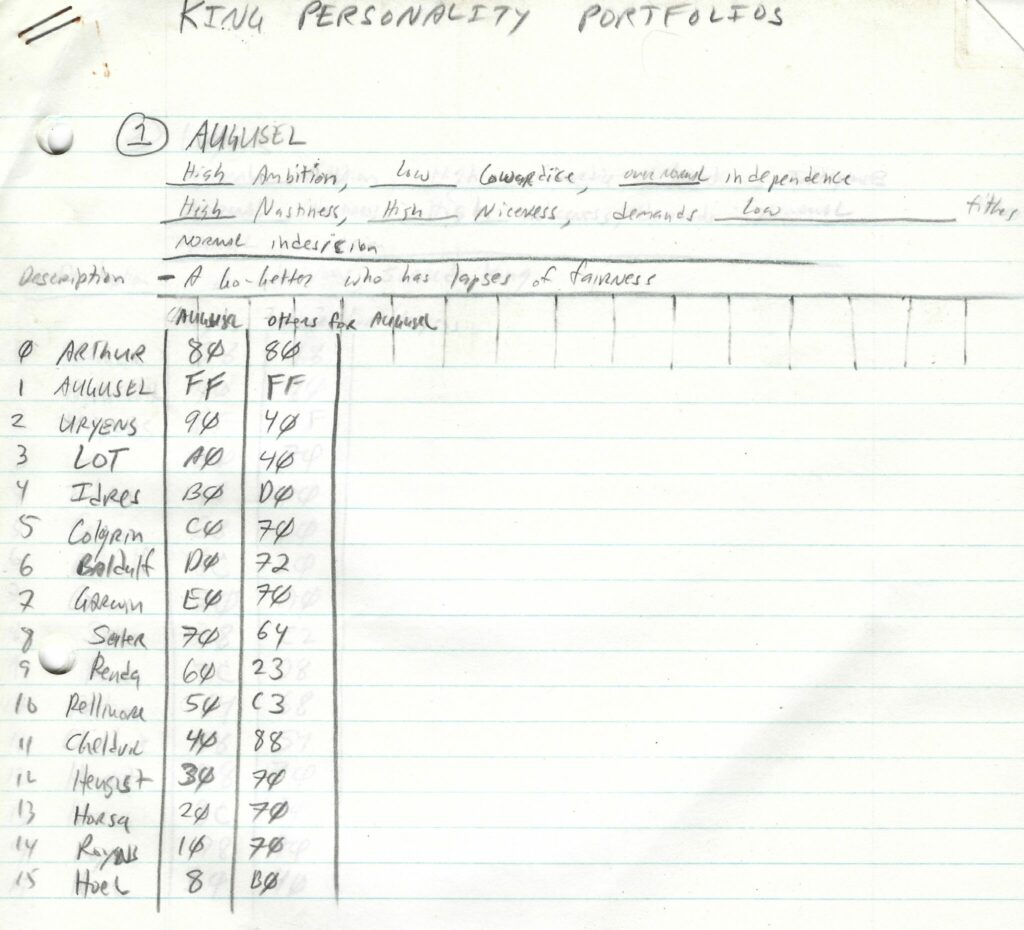
Sources :
The majority of the information I have gathered on Excalibur’s history obviously comes from Chris Crawford, who has extensively documented and discussed his experience. Please note however that in contrast to his similarly numerous accounts on Eastern Front 1941 and Legionnaire, Crawford’s accounts on Excalibur have exhibited some inconsistencies throughout the 30 years in which they were made. In cases where discrepancies arise, I generally gave precedence to his earlier statements.
I also thank the Atari Podcast for interviewing Valerie Atkinson, offering another point of view on the production of Excalibur. Amusingly, Atkinson gives a lot less credit to herself than Crawford gives to her.
Popular Computing, Chris Crawford, Artist as Game Designer, June 1982
Chris Crawford, The Art of Computer Game Design, 1984
Computer Gaming World, Designer’s Notes on Excalibur, August 1984
Computer Gaming World, Designer Profile : Chris Crawford, Part II, January 1987
Chris Crawford, On Game Design, 2003
ANTIC, Chris Crawford complete interview, 2013
ANTIC, Valerie Atkinson interview, 2021
A. Immersion
Good. The first time you launch the game, Excalibur punches hard, well above its era. It is, I believe, the first game to have a partially diegetic interface, in particular, the position of the Knights around the round table is both an “in-universe” element and a UI component visually conveying your reputation.
Another visual marvel is the display of Merlin, so impressive with 1983 technology that even while playing in 2023, I perceived him as a character rather than a magic wand with a long cooldown.
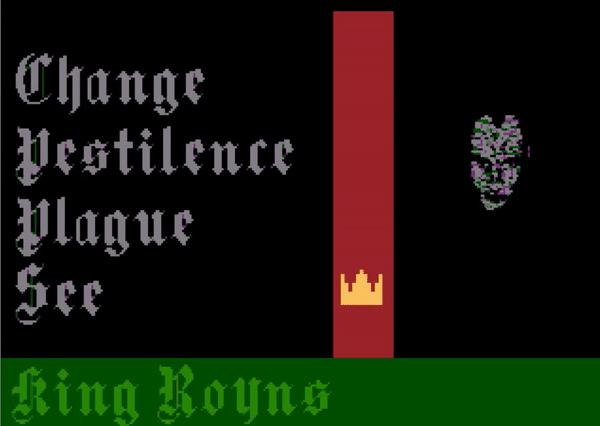
Beyond the game’s visuals, the Knights and other Kings add to the immersion – it’s far more engaging to fight King Penda of Mercia rather than King AI from province #6, especially when King Penda has a distinct personality compared to King Uryens. Excalibur is not the first game with “AI personalities”; Nobunaga’s Ambition had distinctive personalities for each daimyo, but in that game, daimyos died quickly and the impact of their personalities on gameplay soon became secondary to their real military power. In Excalibur, Kings are more resilient, so you get to know them : I knew Hengist would attack me at the first opportunity with a less-than-adequate army, I knew Horsa would pay tribute after each significant victory but attack me the minute I set my foot outside of my castle, that King Colgrin and King Uryens hated each other, and that King Hoel would never attack anyone.
Even some of the game’s weaknesses, like the emptiness of Britain, enhance the immersion: when it takes a minute to move from Camelot to the top third of the map, you start to understand the distance involved.
Finally, I need to discuss the “manual” : it is the only game I know where you learn to play by reading and even annotating a 60+ page novella. It has its flaws : it is competently written, but not exceptionally so, with some clumsy infodumps here and there, and some information is either missing or confusing. Yet, immersion-wise, it works !
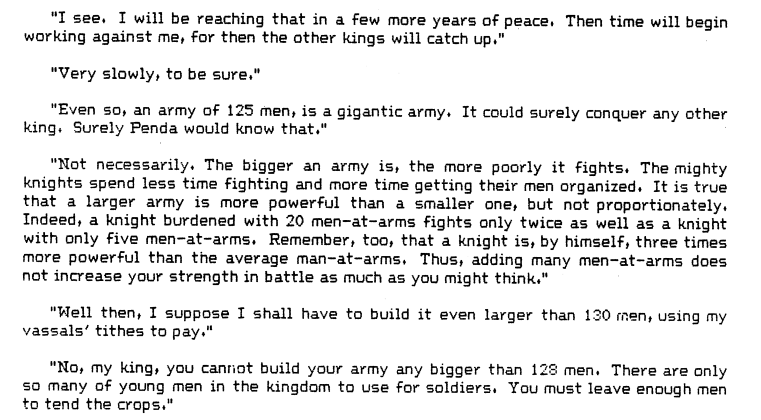
Crawford himself was particularly proud of the idea, whether he describes it as a last-minute concept (The Art of Computer Game Design) or something he always wanted to do (On Game Design), exclaiming in the “designer notes” he wrote for Computer Gaming World : “Maybe it is a mistake, but it is a glorious one !“
Over time, the game’s many issues reduce the immersion, and the mechanical aspects were laid bare by the middle of my campaign – but then, only a fraction of the game I covered attempted to conceal those mechanical parts, and none did it as well as Excalibur.
B. UI, Clarity of rules and outcomes
Poor. Grading this is tricky, Excalibur combining the absolute best but also some infuriating issues. Ultimately, the latter frustrated me more than the former helped me.
Starting with the best aspects : as with all Crawford games, Excalibur can be played using a joystick and ONE button, largely due to the “UI-ish” nature of the CAMELOT module. Equally impressive is the Round Table, which displays a complex network of relationships at a single glance. In contrast, my darling Crusader Kings II requires navigating multiple submenus to determine potential threats. Surprisingly, someone had found a solution to this issue four decades earlier.
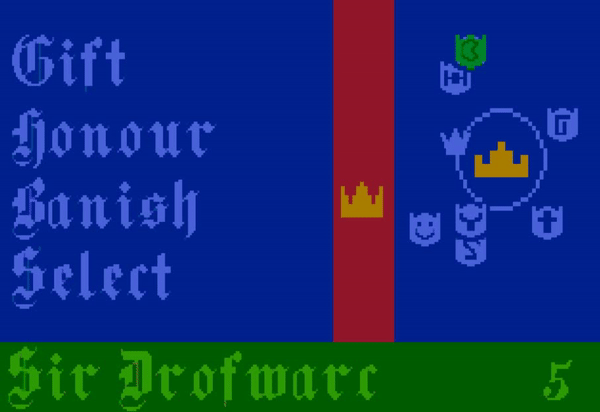
Now, let’s discuss the worst aspects. Two issues marred my experience more than the many others once my campaign began:
- The novella claims that defeating a King in combat makes them your vassal. The issue is that you cannot actually kill Kings in combat. Even when they are the last enemy, surrounded on all sides, “defeating” them merely teleports them to their castle. I spent hours trying to slay King Hengist, up to the point of wondering whether the game was bugged. But it is not a bug : to vassalize Kings, you must raid their kingdom—ideally when they cannot defend it—until they are “ready to abdicate.”
- A significant portion of the game involves defending vassals but, the game conspires to prevent you to do so. You receive warnings when an enemy King attacks Camelot, but not when they target your vassal. To obtain this information, you must frequently check the map room. Worse still, when you arrive at your vassal’s castle to defend it, there’s no indication whether you are on time or if the attack already occurred. Consequently, you may waste time waiting while other Kings target your remaining vassals—since you’re not in the map room, you won’t know if another vassal is under attack. Given how important the whole vassal feature is, this is immensely frustrating by mid-game, particularly because it could have been solved quite easily, for instance by using the same effect that warns you about an upcoming attack on Camelot on those vassals when in their castle.
C. Systems
Poor. On paper, the game includes more features than any other 1983 game, no exception. But those features are shallow and, worse, poorly integrated with one another:
- Crawford spent a lot of time on Knight management, which he envisioned as central to his leadership-focused game. While visually impressive and theoretically intriguing, it didn’t hold up in practice. After banishing the rebellious Knights, Guinevere and her boyfriend, the remaining Knights remained perfectly loyal, and the feature just faded away,
- Similarly, diplomacy was intended to be a core aspect : “warmongers would inevitably lose“. Unfortunately, there are only two diplomatic actions: “declare war” and “pay tribute“. Paying or receiving tribute has little impact on the game’s dynamics—in my campaign, some of my rivals oscillated between “voluntarily paying tribute” and “war” every other tick. Furthermore, the game’s objective is to vassalize all of England, but Kings don’t become vassals voluntarily : it is a “loss” status imposed by warmongering.
To be fair, Crawford was not satisfied with diplomacy either, stating : “I was also disappointed with the very weak system for alliances that we created with the TRIBUTE option. We have once designed an option that allowed the player to create alliances, but it was too ambiguous to enforce. I wish that I had stuck with that idea and made it work.“ - The economy was designed to be as straightforward as possible. Initially, it works well and requires decision-making. However, its integration with the rest of the game is lacking: enemy raids barely impact your crops and treasury if left unchallenged. Additionally, the game’s balance falters as you progress. Once you begin receiving tributes, you accumulate more gold than you could possibly use.
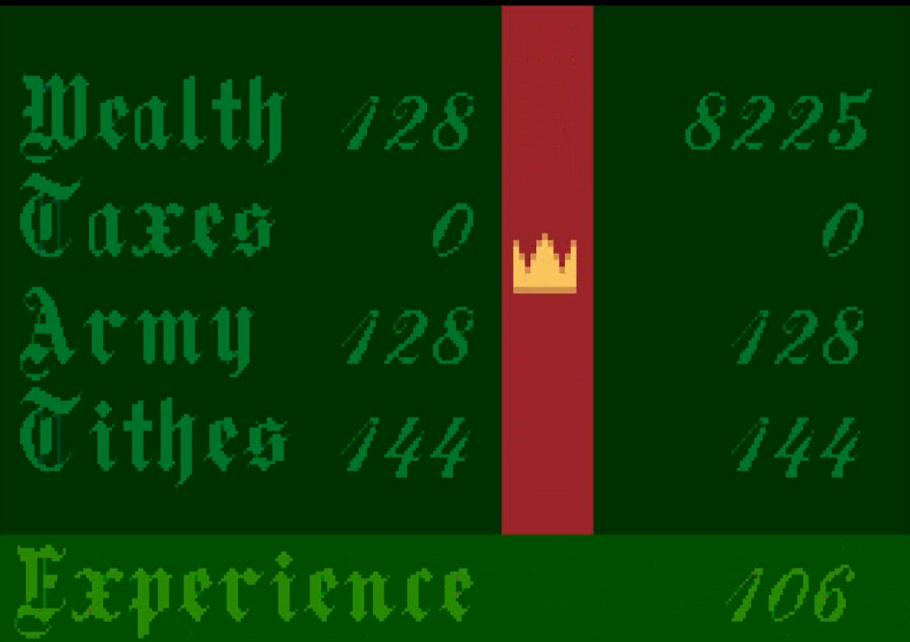
- The world map is empty and has only two purposes : transit and destroying crops during war. One can notice vestigial features : there are cities on the map that cannot be entered and the player can send Merlin’s raven to scout castles whose content you already know.

- This leaves warfare. Crawford aimed to prevent the game from being overly focused on tactics, so he excluded features like terrain that could enable a smart player to consistently defeat a superior army. This makes battles repetitive and occasionally dull, especially when waiting for an enemy to rout on its own without engaging in combat. On the plus side, Crawford succeeded in making the Knights feel distinct during battle ; for example, tasks that are easy for Sir Galahad might prove more difficult for Sir Gawain and nearly impossible for Sir Bedivere.
An inordinate amount of time is spent waiting: for diplomatic events to unfold (since the only “active” option is declaring war, which harms your reputation, wastes experienced soldiers and doesn’t always bring you closer to victory), for enemy armies to approach Camelot (you are informed when an army marches on your castle, but there is no timer), and for the enemy army to advance during battle. This constant waiting is downright exasperating. Of course, the game becomes faster once you learn how to force rival Kings to abdicate, but by then, the perception of the game as “complex” is shattered.
Ultimately, the game consists of shallow features assembled haphazardly – with the exception of the battles – and the whole being not much stronger than the sum of its parts. This contrasts sharply with the tight design of Eastern Front 1941.
D. Scenario design & balancing
Good. It is well-researched, the rival Kings are interesting in design and realistic in terms of behaviour on the battlefield.
E. Did I make interesting decisions ?
Yes. This needs to be qualified. One reason I prefer wargames over RPGs is their resilience to setbacks: in wargames, you can recover from losses, regroup, and hope for victory in the next battle. In contrast, typical RPGs lack expandability—you often can’t lose characters, and a lost battle is usually game over. This leads to frequent reloading in RPGs, which undermines the significance of decisions (“I can just reload and try again if it fails“).
Excalibur offers limited expandability. While Arthur’s death results in an immediate game over, losing Knights can also lead to an essentially unwinnable situation. This forced me to either reload or risk ruining a campaign that spanned several hours. Each reload gradually eroded the perceived taboo of this tactic, and by the second half of my campaign, my mindset became “Let’s try and reload if it fails.” Consequently, decisions became less interesting.
F. Final Rating
[Edited 03/02/2025] Obsolete. ☆☆ Excalibur was incredibly ambitious, innovative, and by the standard of its time an absolutely unique experience you had to play. But 40 years later, there isn’t that much left to experience that cannot be found in more recent games, and too many points of friction to recommend.
Contemporary Reviews
Excalibur never had a chance. It was released around September 1983 by APX, the same month when Atari was burying thousands of E.T. cartridges in a desert in New Mexico. Worst still, Excalibur was only ever featured in one catalogue and had been categorized for some baffling reason as a “Learning” program, sandwiched between Text Formatter and Advanced Fingerspelling. By mid-1984 APX had disappeared and the window of opportunity to buy the game had passed.
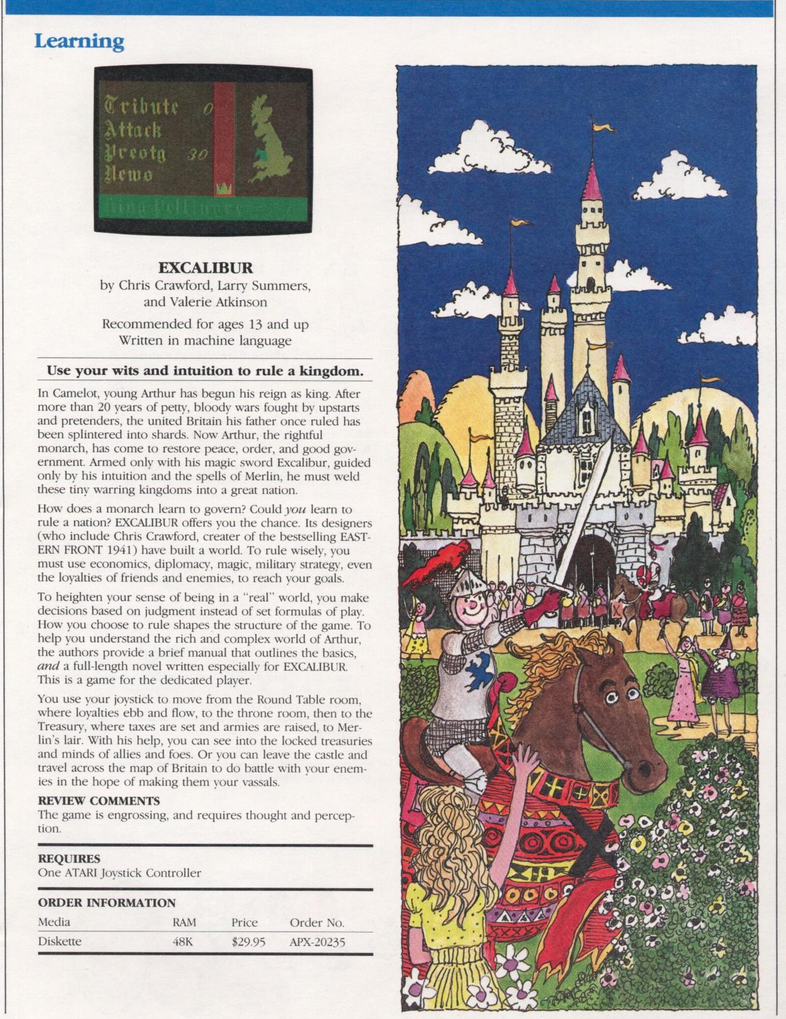
Reviewers of Excalibur fell into essentially two camps: a minority of reviewers praised it to the skies, though always warning their readership about the complexity of the game. The majority probably did not even notice the game existed and ignored it.
The first review I could find is from Electronic Games in January 1984 : “Excalibur isn’t a game for the weak, since it requires a fair amount of patience”. “All in All, Excalibur is a grand effort, its wargame-style graphics are colorful and easily understood while the game itself is playable again and again”. In February 1984, ANTIC doubled down, stating : “An exceedingly complex game (perhaps the most complex yet written for an eight-bit computer!)” “It’s impossible to play Excalibur with the mindset you might use for a game of Pacman, for example […] but it is an investment that can pay off in one of the richest gaming experiences ever”. As for the 1984 Atari Book of Software, it is straightforward : “Excalibur is destined to become a cult game”.
Computer Gaming World only reviews Excalibur in August 1984 – at this date the game was possibly not available anymore. In an article titled “Review, Strategy and Tactics for Excalibur, David Townsend lavishly praises the game, stating that “Excalibur is a magnificent piece of software“, before giving inane strategic advice. 6 years later in 1990, Evan Brooks gives the game 4 stars : “[Excalibur] still generates a recommendation, even on an obsolete machine.“
Ultimately, Excalibur’s harshest critic was Crawford himself. He consistently lambasted his own game for falling short of the ambitions he had for it. Next to the August 1984 Computer Gaming World review, he published “designer notes”, in which he states : There remain flaws that give me pain. The game is still too “wargamy” for my taste; I wanted a game that would emphasize the non-military aspects of leadership. In EXCALIBUR, lack of military prowess will doom you, but lack of other skills (diplomatic, economic) will only cripple you. That’s too wargamy.”
Still, the game had a special place in Crawford’s heart. In the same article, he states that his greatest regret was that “Excalibur had not won the attention that I think it deserves. […] It is a shame that so few people are even aware of its existence.” Three years later in January 1987, as he was taking stock of his career thus far in an interview to Computer Gaming World, he called it one of the 3 games he was most proud of (with Eastern Front 1941 and Balance of Power) because of “the ambitiousness of the attempt. It did not succeed anywhere near as well as I had hoped, but there’s still a lot to be proud of”.
Chris Crawford would return to the topic of social interaction and develop the “Leadership” gameplay of Excalibur in Trust & Betrayal: The Legacy of Siboot (1987) – the game he stated he was the proudest of when he gave an interview to ANTIC in 2013. He also returned to the Arthurian Legends with what he calls his magnum opus : “Le Morte d’Arthur”, released in December 2022 and playable directly on his website. I must warn you that it starts slowly, I must confess that I did not finish it yet ; still I believe that a part of my audience may like it.